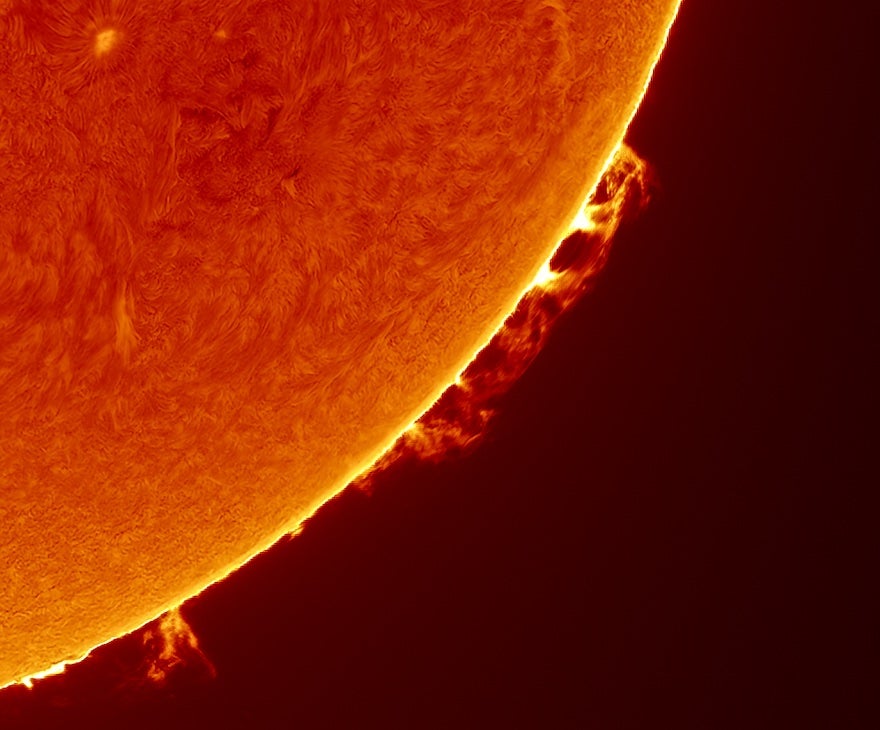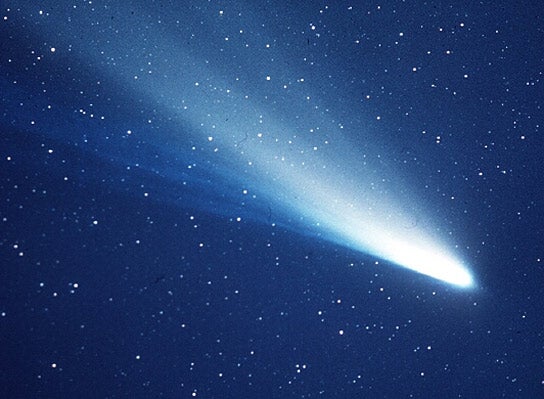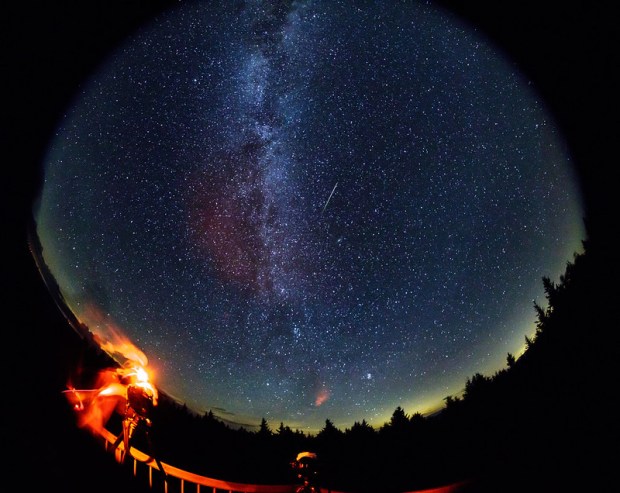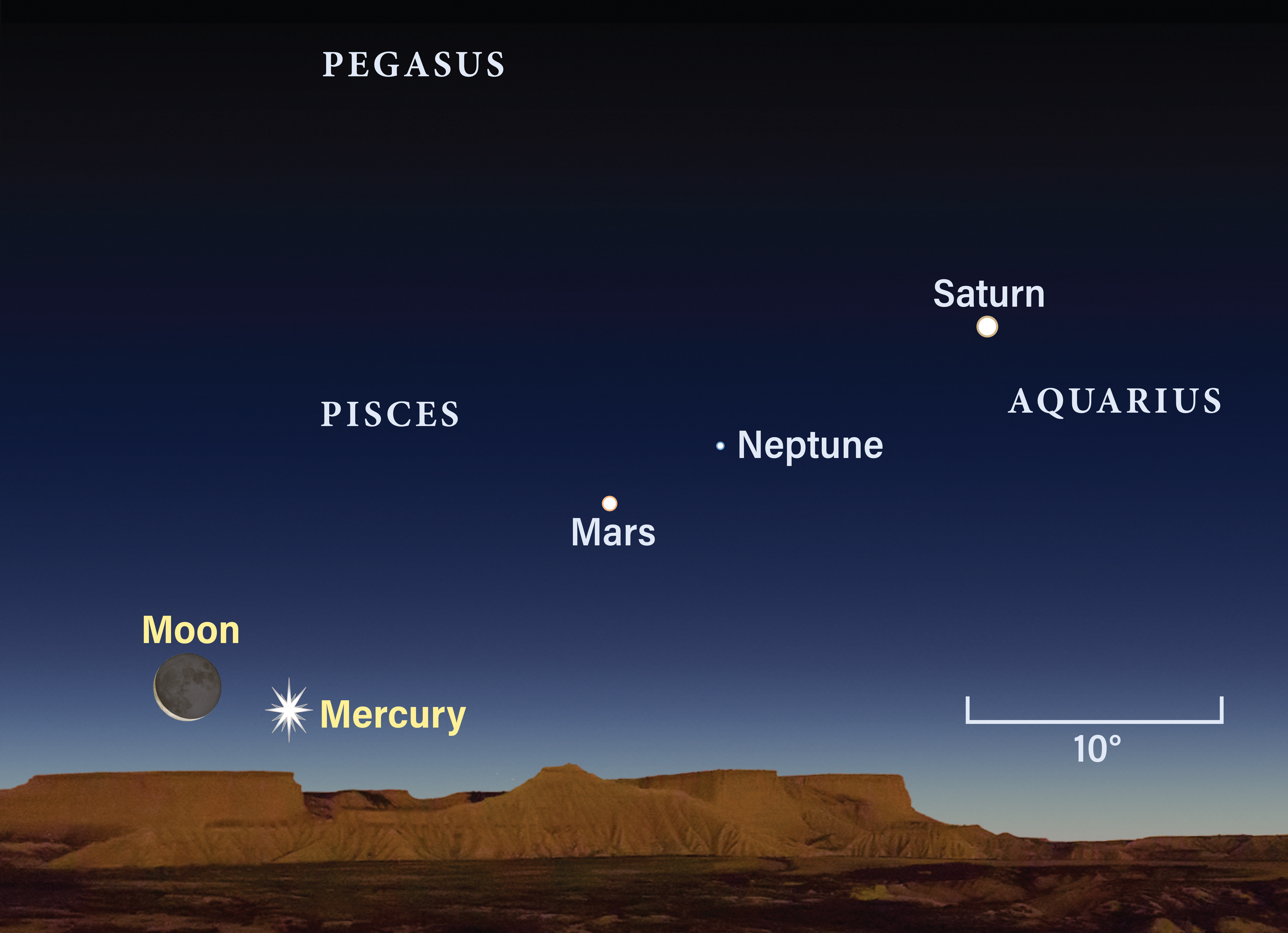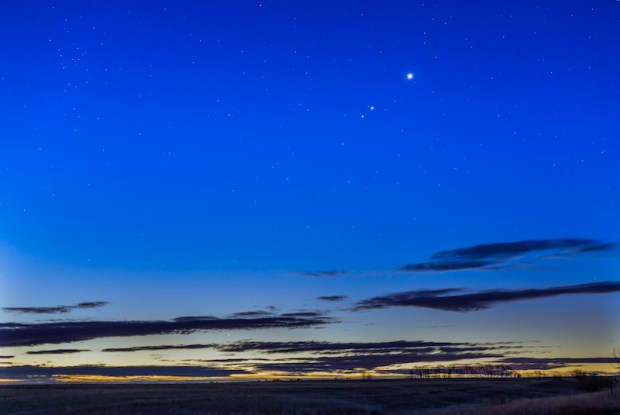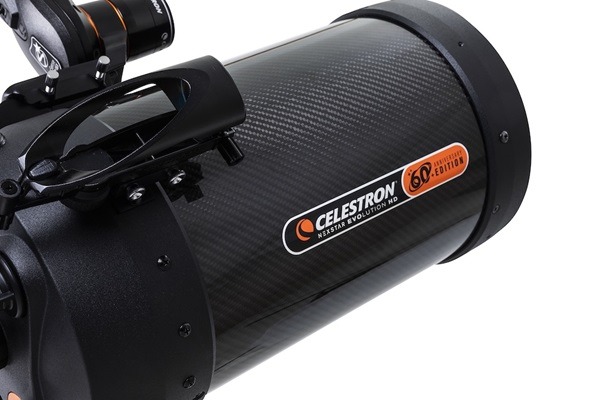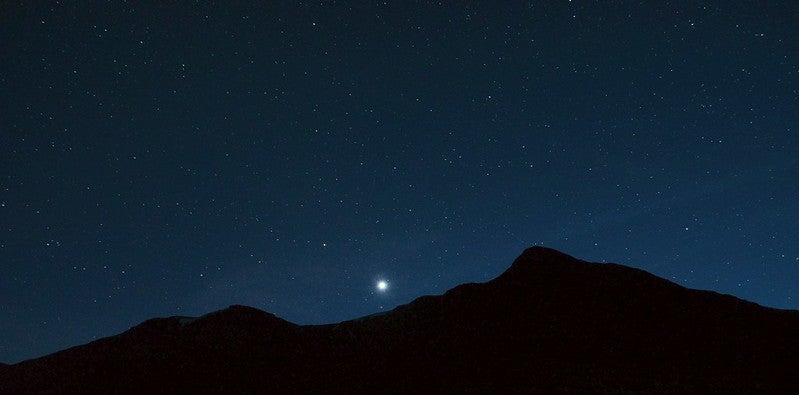
Friday, July 7
Have you noticed that bright, steady point of light lingering in the west after sunset for months? That’s Venus; at 10 A.M. EDT today, the planet reaches greatest brilliancy, blazing at magnitude –4.7. By evening, it hangs some 20° high as the Sun is sinking and will slowly set over the next two hours, offering a nice, long window to enjoy it.
Located in Leo the Lion, Venus sits close to Mars, which lies to Venus’ upper left (east). The Red Planet is a much dimmer magnitude 1.7, still visible as the sky begins to darken. Can you tell that its softer glow is also much redder, thanks to sunlight reflecting off its ruddy surface? Just to Mars’ left (southeast) is magnitude 1.4 Regulus, the bright star marking the Lion’s heart. Mars will make a close pass of this star in just a few days.
But first, take some time to enjoy bright Venus as the first stop in your evening observing session. Catching the planet through binoculars or a telescope while the background sky is still bright is advantageous in this case, as it can reduce glare and bring out the 26-percent-lit crescent more clearly. Venus, which is roughly the same size as Earth, now appears a whopping 37″ across in the evening sky —the same width that Jupiter currently spans!
Asteroid 15 Eunomia reaches opposition at 4 P.M. EDT. Eunomia is visible in Sagittarius, best seen floating above the southern horizon in the hours before dawn if you decide to stay up overnight.
Sunrise: 5:38 A.M.
Sunset: 8:31 P.M.
Moonrise: 11:52 P.M.
Moonset: 10:28 A.M.
Moon Phase: Waning gibbous (76%)
*Times for sunrise, sunset, moonrise, and moonset are given in local time from 40° N 90° W. The Moon’s illumination is given at 12 P.M. local time from the same location.
Saturday, July 8
The Moon passes 1.7° south of Neptune at 10 A.M. EDT; several hours earlier, you can spot the pair in the predawn sky, hanging above the southeastern horizon. The best time is at least two hours (or more) before sunrise, while the background sky is still dark enough to prevent washing out Neptune’s feeble magnitude 7.7 glow. The planet will require binoculars or a telescope to view, as this is too faint for the naked eye to pick up.
Light from the nearby Moon will make your search a bit harder, but be diligent. Neptune sits about 4.7° northeast of the Moon early this morning, directly below (southeast of) the Circlet of Pisces asterism. Its small, 2″-wide disk will appear as a “flattened,” gray-blue star.
While you’re up, turn east to catch the constellation Perseus, already 30° above the horizon two hours before sunrise and climbing. The Hero houses the famous Double Cluster, a pair of open clusters cataloged as h and Chi (χ) Persei. They’re located in the northwestern portion of the constellation, close to its border with Cassiopeia. In fact, the easiest way to find this favorite deep-sky target is to use Epsilon (ε) and Delta (δ) Cassiopeiae as your signposts. Draw a line between these two stars with your eye and locate the midpoint. From there, look about 7° southeast and you’ll land on the Double Cluster.
The best way to view these open clusters is with binoculars or even your finder scope. Low magnification will show them together in the same field, as they’re separated by about 30′, roughly the width of the Full Moon. Chi lies to the east, while h is to the west. You can zoom in on each with higher magnification and enjoy their sparkling stars — look particularly for those with contrasting colors, as both clusters contain hotter, bluer stars alongside cooler, redder suns.
Sunrise: 5:39 A.M.
Sunset: 8:31 P.M.
Moonrise: —
Moonset: 11:42 A.M.
Moon Phase: Waning gibbous (65%)
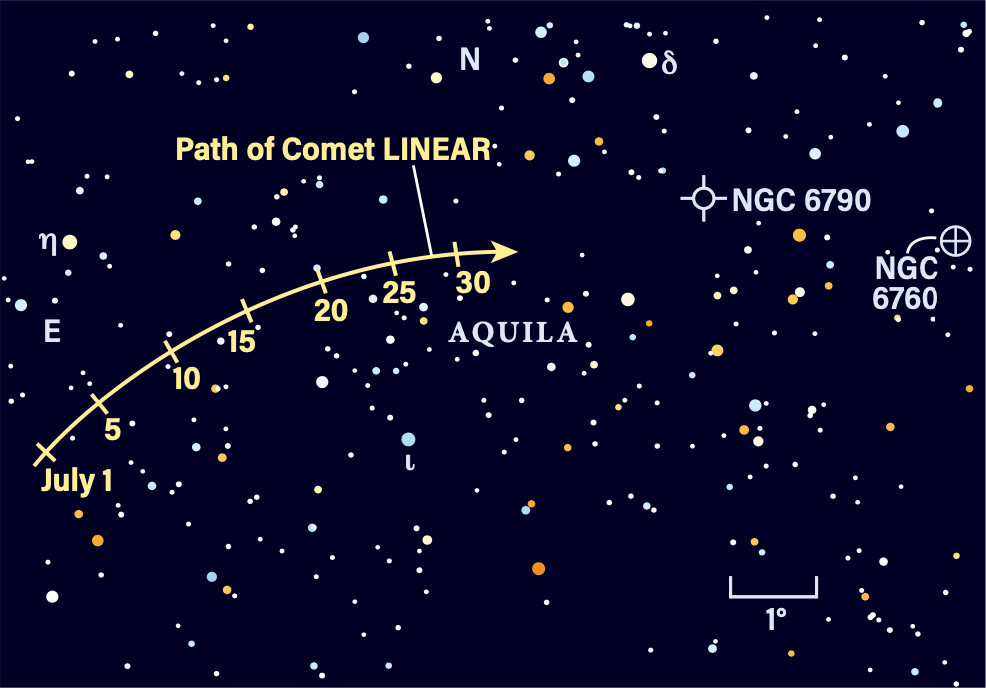
Sunday, July 9
Last Quarter Moon occurs at 9:48 P.M. EDT; during this phase, our satellite dominates the early-morning sky, leaving evening skies dark and ideal for finding fainter objects. Tonight, let’s try for Comet 237P/LINEAR, currently soaring through Aquila the Eagle and rising in the east after sunset.
Let the sky grow dark and look for bright Altair, the Eagle’s alpha star. About 8.5° to its west-southwest is 3rd-magnitude Delta Aquilae. From this star, drop about 6.8° southeast to look for LINEAR’s faint, 11th-magnitude glow. Larger scopes (8 inches or more) will really help you out here, as they’ll better capture this faint fuzzball’s light. Drop in 150x magnification or more once you’ve centered on the comet.
If your scope is a bit smaller or your sky suffers from light pollution, try for a slightly brighter target instead: nearby NGC 6760. This compact globular cluster sits about 4° west-southwest of Delta and shines at 9th magnitude, stretching just 6′ across. If you do have dark skies and good seeing, you can also try for 10th-magnitude planetary nebula NGC 6790, just over 1.5° south of Delta.
Sunrise: 5:40 A.M.
Sunset: 8:31 P.M.
Moonrise: 12:16 A.M.
Moonset: 12:53 P.M.
Moon Phase: Waning gibbous (54%)
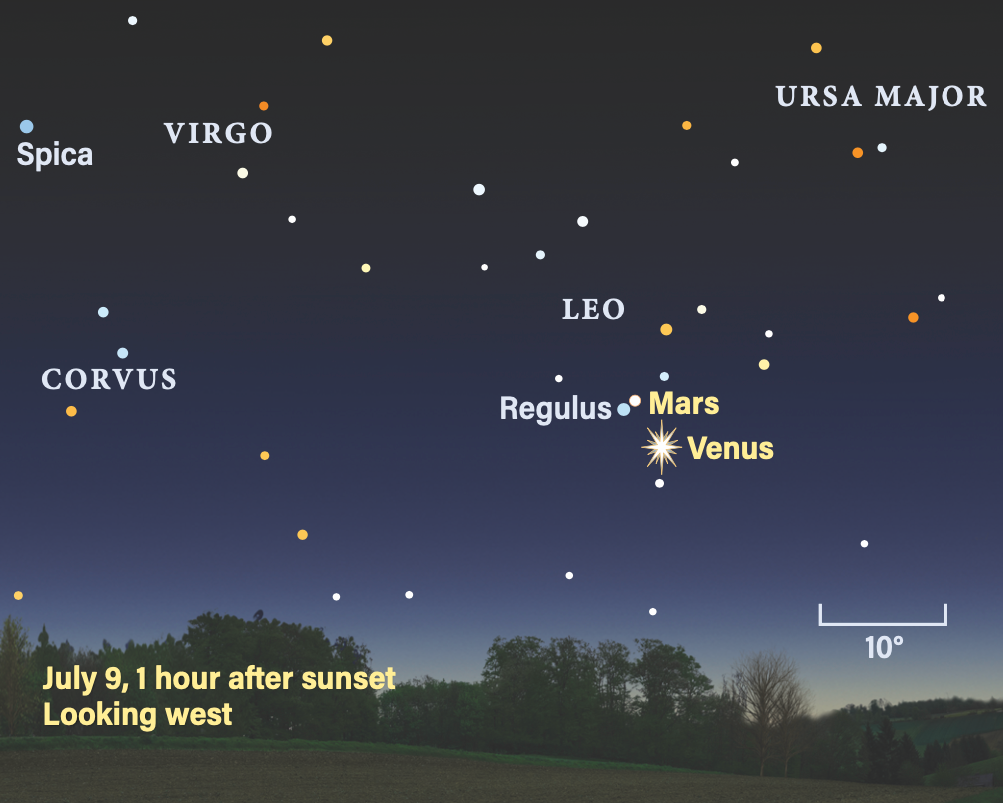
Monday, July 10
Slowly making its way across Leo, Mars passes 0.7° north of Regulus at 4 A.M. EDT. You can view them this evening in the west after sunset, with the Red Planet now slightly northeast of the star. Through a telescope, compare their colors — Regulus is a hot B-type star some 150 times brighter than the Sun and nearly 3.5 times as massive. Next to Mars’ ruddy glow, the 1st-magnitude star should appear a brilliant blue-white.
If you’re in a dark location, you can use Venus and Mars as guides to find the ecliptic, the plane of the solar system. It’s along this plane that dust from past cometary passes settles, scattering sunlight to create the zodiacal light. Once darkness falls, look for a faint, cone-shaped glow extending along the ecliptic, spreading upward from Cancer through Leo.
The ecliptic continues along the sky and passes just north of Spica, Virgo’s bright alpha star, which lies east of Leo.
Sunrise: 5:40 A.M.
Sunset: 8:30 P.M.
Moonrise: 12:40 A.M.
Moonset: 2:02 P.M.
Moon Phase: Waning crescent (43%)
Tuesday, July 11
The Moon passes 2° north of magnitude –2.2 Jupiter at 5 P.M. EDT. Neither is visible at that time; instead, early risers will see them in the morning sky. Find the pair in the east a few hours before dawn, located in southern Aries. The waning Moon now sits about 5° west of the planet in the sky.
You’ll want to pull out your telescope to zoom in on Jupiter, whose volcanic moon Io transits the disk this morning. The event begins around 4:35 A.M. EDT as the moon’s shadow appears on the cloud tops. East Coast observers will lose the view in the growing twilight, but those farther west will catch Io slipping onto the disk nearly an hour and a half later, at 4:51 A.M. CDT.
Both track across the planet as the sky brightens; depending on your location, you may lose the view before they move away. The shadow slips off the western limb just before 5:45 A.M. CDT, minutes after the Sun rises in the Midwest (and your telescope should be put away). Those farther west can still catch its disappearance. Io itself continues across the planet’s face, leaving around 5 A.M. PDT.
Throughout Io’s transit, Jupiter’s other Galilean moons maintain their positions: Ganymede sits far to the planet’s east, while Europa (closer) and Callisto are arrayed to the right.
Sunrise: 5:41 A.M.
Sunset: 8:30 P.M.
Moonrise: 1:05 A.M.
Moonset: 3:11 P.M.
Moon Phase: Waning crescent (33%)
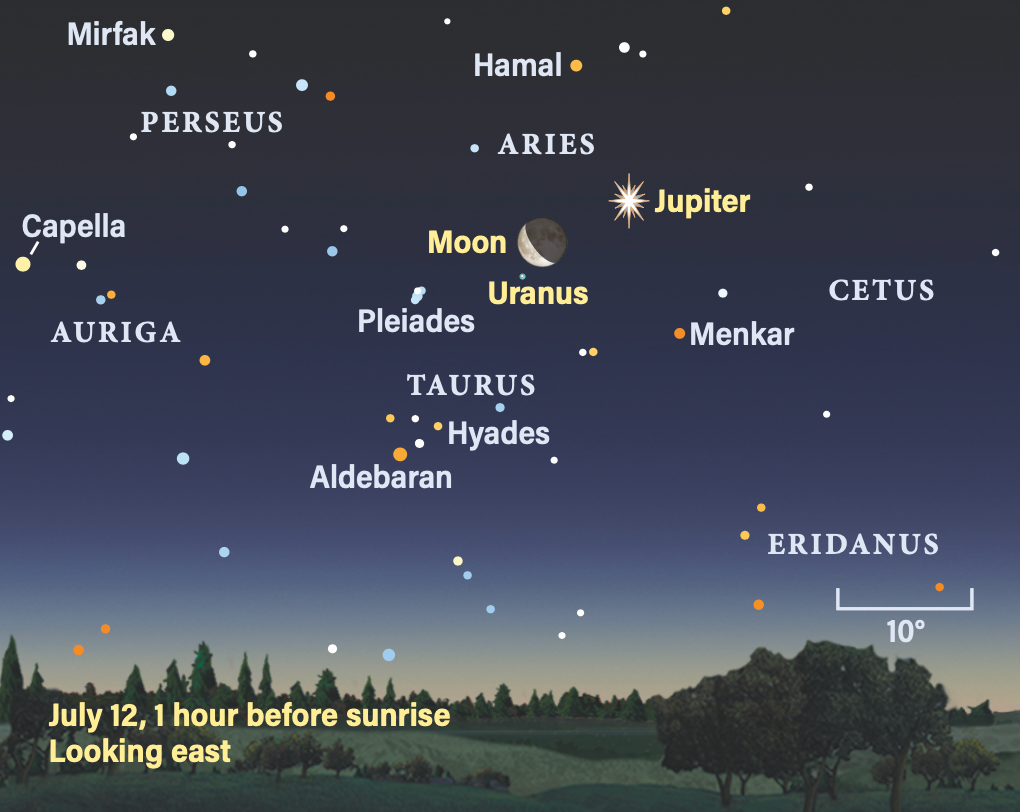
Wednesday, July 12
The Moon continues making its way through Aries, passing 2° north of Uranus at 2 P.M. EDT. Once again, it’s an early morning if you want to catch the pairing in the predawn sky in the hour or two before sunrise, as the delicate crescent Moon hangs less than 4° west of the ice giant, slowly closing in to make its northern pass.
Uranus lies just at the edge of naked-eye visibility at magnitude 5.8 — your best bet is to use binoculars or a telescope to home in on its position just under 2.5° southeast of 4th-magnitude Delta Arietis.
The real showstopper of the morning sky, however, is the Pleiades (M45), across the celestial border in Taurus. The cluster lies 9° northeast of Uranus and nearly 20° northeast of Jupiter, appearing to sit directly above the V-shaped face of the Bull as the constellation rises above the horizon. This is our target for tomorrow morning, when the Moon will have crossed into Taurus to hang beneath this young cluster of stars.
Sunrise: 5:42 A.M.
Sunset: 8:29 P.M.
Moonrise: 1:33 A.M.
Moonset: 4:19 P.M.
Moon Phase: Waning crescent (23%)
Thursday, July 13
The Moon now sits less than 3° below the center of the Pleiades cluster in Taurus, offering a gorgeous naked-eye view for anyone up before the Sun. Around 4 A.M. local daylight time, you’ll easily spot the pair about 20° above the eastern horizon.
The Moon is just a delicate sliver less than 20 percent lit. Above it, the Pleiades spread out over an area 4 times the Full Moon’s width. This group of young suns has been known since ancient times. Sometimes called the Seven Sisters, it can also be mistaken for the Little Dipper, as some observers think it looks a bit like a tiny spoon. (However, the real Little Dipper is a much larger asterism in the north!)
Below the Pleiades is the familiar V shape of Taurus, marked by the bright red giant Aldebaran, which serves as one eye. At the tip of the V is the Hyades, another young cluster of stars scattered even wider than the Pleiades, spreading across an area at least twice as wide.
Sunrise: 5:42 A.M.
Sunset: 8:29 P.M.
Moonrise: 2:04 A.M.
Moonset: 5:26 P.M.
Moon Phase: Waning crescent (15%)
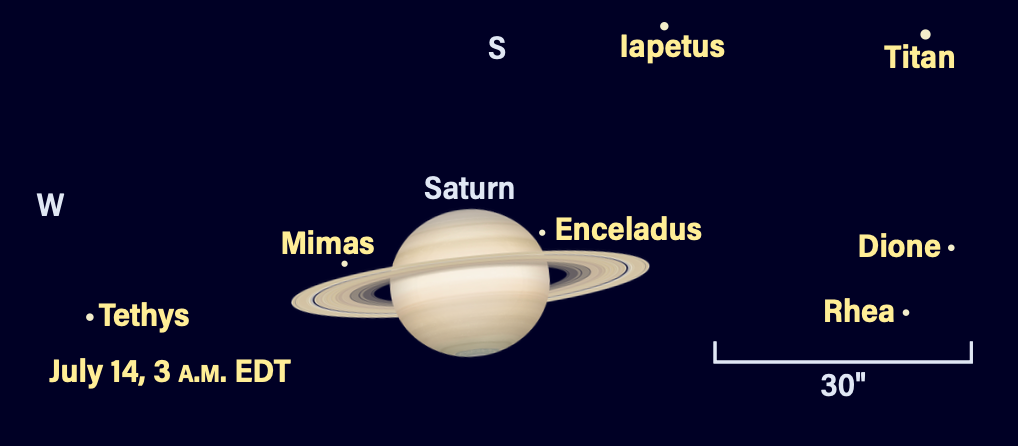
Friday, July 14
Let’s finish out a week of great early-morning observing by catching Saturn surrounded by several of its moons. Unlike the Galilean moons of Jupiter, Saturn’s satellites are generally fainter and harder to catch, except for magnitude 8.5 Titan (the largest and brightest of the entourage).
Magnitude 0.6 Saturn is located in Aquarius and is more than 30° high in the southeast around 3 A.M. local daylight time. It’s still getting higher by the hour, not yet having reached its highest point in the southern sky. Swing a telescope up to capture the ringed planet in your eyepiece and take a moment to first enjoy its standout feature: the rings, which stretch to more than double the width of the planet’s 18″-wide disk.
At 3 A.M. EDT, two moons hover just south of those rings: Mimas on the west and Enceladus on the east. These moons are faint (12th to 13th magnitude) and are quite difficult to pick up in the glare of the planet and rings, but a large scope may do it. They are both tracking west — Enceladus and its shadow cross the planet’s southern hemisphere from about 3 A.M. to 5:20 A.M. EDT.
Slightly easier to spot, magnitude 10 Tethys lies less than 30″ from the western tip of the rings. And easiest of all to locate will be bright Titan, about 1′ southeast of the planet’s center. Just north of Titan are 10th-magnitude Dione and Rhea. But what you really want to use Titan for is locating Iapetus, which sits 30″ due west of the bright moon. Iapetus is fading toward 11th magnitude as it moves east from its western elongation, when it was brightest (around 10th magnitude).
Sunrise: 5:43 A.M.
Sunset: 8:28 P.M.
Moonrise: 2:41 A.M.
Moonset: 6:29 P.M.
Moon Phase: Waning crescent (9%)

Sky This Week is brought to you in part by Celestron.

